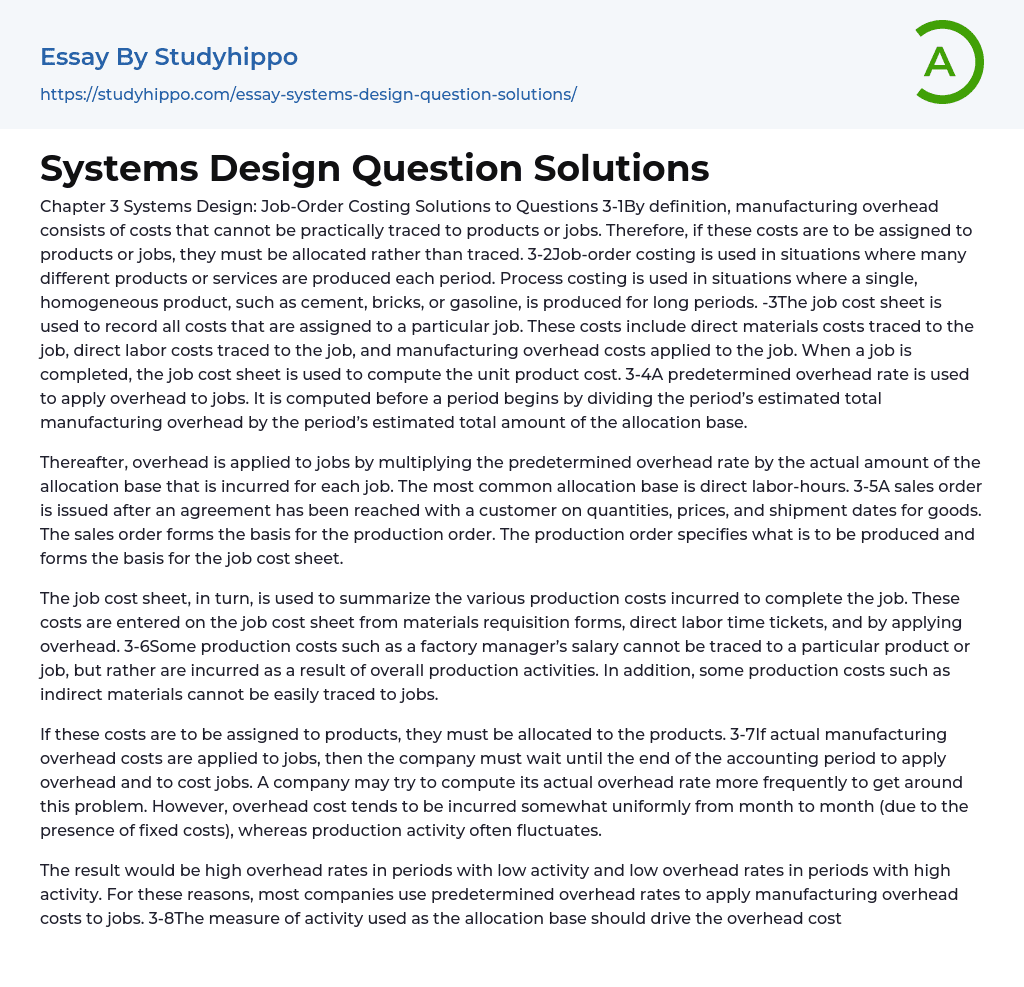Therefore, if these costs are to be assigned to products or jobs, they must be allocated rather than traced. Job-order costing is used in situations where many different products or services are produced each period. Process costing is used in situations where a single, homogeneous product, such as cement, bricks, or gasoline, is produced for long periods. The job cost sheet is used to record all costs that are assigned to a particular job. These costs include direct materials costs traced to the job, direct labor costs traced to the job, and manufacturing overhead costs applied to the job. When a job is completed, the job cost sheet is used to compute the unit product cost. A predetermined overhead rate is used to apply overhead to jobs. It is computed before a period begins by dividing the period’s estimated total manufa
...cturing overhead by the period’s estimated total amount of the allocation base.
Thereafter, overhead is applied to jobs by multiplying the predetermined overhead rate by the actual amount of the allocation base that is incurred for each job. The most common allocation base is direct labor-hours. A sales order is issued after an agreement has been reached with a customer on quantities, prices, and shipment dates for goods. The sales order forms the basis for the production order. The production order specifies what is to be produced and forms the basis for the job cost sheet.
The job cost sheet, in turn, is used to summarize the various production costs incurred to complete the job. These costs are entered on the job cost sheet from materials requisition forms, direct labor time tickets, and by applying overhead. Some
production costs such as a factory manager’s salary cannot be traced to a particular product or job, but rather are incurred as a result of overall production activities. In addition, some production costs such as indirect materials cannot be easily traced to jobs.
If these costs are to be assigned to products, they must be allocated to the products. If actual manufacturing overhead costs are applied to jobs, then the company must wait until the end of the accounting period to apply overhead and to cost jobs. A company may try to compute its actual overhead rate more frequently to get around this problem. However, overhead cost tends to be incurred somewhat uniformly from month to month (due to the presence of fixed costs), whereas production activity often fluctuates.
The result would be high overhead rates in periods with low activity and low overhead rates in periods with high activity. For these reasons, most companies use predetermined overhead rates to apply manufacturing overhead costs to jobs. The measure of activity used as the allocation base should drive the overhead cost; that is, the base should cause the overhead cost. If the allocation base does not cause the overhead, then costs will be incorrectly attributed to products and jobs and product costs will be distorted. Assigning manufacturing overhead costs to jobs does not ensure a profit. The units produced may not be sold and if they are sold, they may not be sold at prices sufficient to cover all costs. It is a myth that assigning costs to products or jobs ensures that those costs will be recovered. Costs are recovered only by selling to customers—not by allocating
costs. Generally, the amount of overhead applied will not be the same as the amount of actual cost incurred, since the predetermined overhead rate is based on estimates. Underapplied overhead occurs when the actual overhead cost exceeds the amount of overhead cost applied to jobs during the period. Overapplied overhead occurs when the actual overhead cost is less than the amount of overhead cost applied to jobs during the period. Underapplied or overapplied overhead is disposed of by either closing out the amount to Cost of Goods Sold or by allocating the amount among Cost of Goods Sold and ending inventories in proportion to the applied overhead in each account.
- Audit essays
- Budgeting essays
- Cost Accounting essays
- Architecture essays
- Design essays
- Graffiti essays
- Graphic essays
- Interior design essays
- Painting essays
- Photography essays
- Sculpture essays
- Typography essays
- Accounting essays
- Andrew Carnegie essays
- Automation essays
- Business Cycle essays
- Business Intelligence essays
- Business Model essays
- Business Operations essays
- Business Software essays
- Cooperation essays
- Cooperative essays
- Corporate Social Responsibility essays
- Corporation essays
- Customer Relationship Management essays
- Family Business essays
- Franchising essays
- Harvard Business School essays
- Harvard university essays
- Human Resource Management essays
- Infrastructure essays
- Inventory essays
- Logistics essays
- Management essays
- Manufacturing essays
- Market essays
- Marketing essays
- Multinational Corporation essays
- News Media essays
- Online Shopping essays
- Quality Assurance essays
- Richard Branson essays
- Sales essays
- Selling essays
- Shopping Mall essays
- Small Business essays
- Starting a Business essays
- Stock essays
- Strategy essays
- Structure essays




